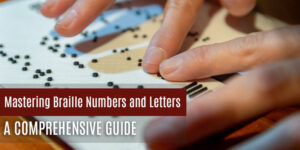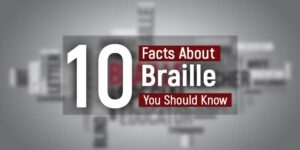The world is constantly changing and ensuring an inclusive world for all is important. For people who are blind or visually impaired individuals accessible documents are a crucial step towards inclusivity.
In this blog, we will take a stroll through the basics of making documents that everyone can read, regardless of their visual disabilities.
Understanding Accessibility
Before we get to know about how to create accessible documents, let’s understand why it matters. Accessibility is about making sure that the information is available to everyone, regardless of their abilities or disabilities.
For people who are blind, this means designing documents in a way that allows them to perceive and understand the content using non-visual methods.
1. Use of Headers and Styles
A well-organised library with all the Headers and styles in a document plays a similar role. They provide structure and help in creating an organized and easy-to-navigate document.
When creating documents, use headings to break down information into sections. This not only makes the document look visually appealing but also assists them with the screen reader, a tool that reads the content to users who are visually impaired. Properly structured documents enhance the overall reading experience.
2. Alternative Text for Images
A picture may be worth a thousand words, but for someone who can’t see it, those words need to be described. This is where the alternative text comes in.
When inserting images into your document, always provide a brief and descriptive alternative text. Screen readers use this information to convey the meaning of images to users who are blind.
3. Contrasts and Colours
For logos and font colours make sure that the contrast ratio is adequate for someone with low vision. Ensure there is enough contrast between the text and background making it easier for everyone to read including the visually impaired individuals.
4. Fonts and Size
Additionally, choose a relatable font and an appropriate font size. Basic fonts like Calibari, Aerial, and Verdana, are the best fonts and are the default on most processors like Word and Google Docs.
While decorative fonts look fancy and cool it is challenging for screen readers to interpret the text on the screen. Instead, use bold text to highlight the important information
Stick to clear and simple fonts and make the font size large enough to be comfortably read.
5. Readability of Text
Imagine reading a novel with faded ink and a tiny font. Quite annoying, huh? The frustration with digital documents is the same. Make sure your font is readable and select a style that is easy to read.
Additionally, keep the text and background colours in good contrast. For good reason, black text on a white background is a timeless design that is readable by all.
6. Hyperlink Clarity
In the digital world, hyperlinks are like doors that lead to new content. Make sure these portals are labelled clearly for people who use screen readers. Provide a link that says “click here” but also contains some descriptive text that points to the location instead.
7. Accessibility Tools and Testing
The process of producing accessible documents isn’t one-size-fits-all. Fortunately, there are resources available to assist you during this process. Utilize accessibility checkers to find possible problems and fix them. Also, use screen reader software to test your document to make sure blind users have an easy time with it.
8. Document Formats Matter
Different document formats have varying levels of accessibility. When possible, choose formats that support accessibility features. PDFs, for example, can be made accessible with proper tagging and alt text. However, HTML documents are inherently more accessible and adaptable to different devices.
9. Empathy in Design
Designing with empathy means putting yourself in someone else’s shoes. Consider the user experience for individuals who are blind at every stage of document creation. By doing so, you contribute to a more inclusive digital landscape where information is truly accessible to everyone.
Conclusion
Creating accessible documents for people who are blind is not just a technical requirement; it’s a step towards a more inclusive and compassionate world. As we weave accessibility into the fabric of our digital content, we open doors for individuals who are blind, empowering them to navigate the vast landscape of information with ease.
Remember, accessibility is not a checklist but a mindset. It’s about recognizing diversity, embracing differences, and ensuring that no one is left behind in the journey of knowledge and discovery. So, let’s embark on this journey together, crafting a digital world where everyone has equal access to information and opportunity.
Contact Braille Music and More today for Braille Services!







